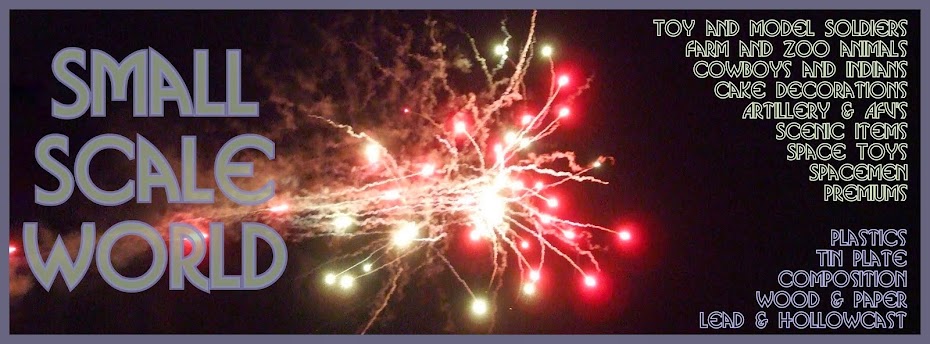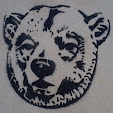The reason I consider it to be such an iconic early plastic toy is that it was produced, licensed and copied by so many companies or as 'brands' and it showed how a simple mechanism in a plastic toy, if robust enough, could produce the same level of 'playability' as a much more complicated (and expensive to produce) metal clockwork or friction-motors in the previous staple - tin-plate toys.
The thanks go to Bill Hanlon and Adrian Little, who have both helped with images and information.
Bill's Website is here; American Dimestore
Adrian's is here; Mercator Trading
So the first incarnation seems to be the last photographs to join this article - taken the other week. Designed by Islyn Thomas, originally for The Acme Plastics Manufacturing Company of New York in 1945, it looks very modern, lacking a rear rotor would cramp it's style in the air somewhat, but 'junior' wouldn't have known that!
It is so modern in fact, it seems to represent a shape that wouldn't be built for some years, being given a 'nose' that was lacking in the Sikorsky R4 Hoverfly, the only volume production airframe at the time, but then it was sold as a Bell Helicopter - none of the early models from that company looking anything like the toy, however, there would have been some drawing-board designs that could have led to this shape being adopted, and - due to the war - there were some close connections between toy makers and defence companies.
The box is square using the longest dimension, and the simple mechanism meant you could pull it along by its little string and the rotors would revolve. Faster you pulled - the more action you generated...bargain!
The fogging on the wheels would suggest a material other that styrene, possibly a cellulose-based polymer. Although Cellulose-acetate was used on early ACME and Thomas toys, I've never seen one of these helicopters in that material, they all being in polystyrene.
By 1947, it would seem that the ACME contract with Thomas Manufacturing Corp. was coming to an end (or at least the order for helicopters had been filled?) and on Bill's website we see a generic letter offering the helicopter to all-comers. Above - courtesy of Bill; is a collage of various boxes, by various manufacturers including a French company who obviously took Islyn up on his offer. The box is now based on the maximum breadth dimension.
Because Thomas had a UK arm near Swansea in Wales, the UK versions were probably sourced from there rather than the 'States, however the mould-sharing regimen of the time, US import/export [protectionism] tax implications and order-filling may have led to all sorts of relationships between companies, boxes and contents!
However as this letter (also supplied by Bill) shows, Injection Moulders (IM) were talking to the US parent. In 1953 there is another letter from IM (on Bill's site) talking about a new Sikorsky helicopter, and that they have "...re-hashed it again...", this may well be the following one....
...and this is where my own efforts toward this article finally kick-in, as about 18 months ago I had the luck to secure the following by IM at the bun-fest on the steps of the stand at Sandown Park before the doors open;
The box and contents are given a space-age feel but very much in the style of Buck Rogers, Dan Dare or Flash Gordon, what they thought in the 1950's the world would look like in the 2000's!
The Inter Cities 'Rota Ship' in a fetching gold with a folding flap that turns its box into a garage. Unlike the Acme model, this (and most others) carries the Thomas patent number.
Although I had started to collate this article when I did the text-less space-ship articles some time ago, as soon as I got this I lent it out for a book project, so everything was put on hold for a while longer.
We've seen the green one before, with a question mark over it's being Tudor*Rose or Kleeware, I now suspect it is another IM version/issue but could equally be either Thomas or Poplar Plastics, and - again on Bill's site - there is a nice shot of several of these with the generic box . The broken rotor'ed one we looked at last time has the original RAF roundel, while the complete one I got about a year ago has lost it.
Fairylite, who we looked at the other day were an importer/re-packager of other peoples product and their model could have come from anywhere, even Hong Kong where this helicopter was copied, but I feel it will be one of the UK factories (Thomas, Poplar or IM) who supplied it, as the HK ones tend to be glossier and of less quality.
While most of the models in this article are mono-coloured (ignoring the rotor/wheel mechanism). bi-coloured ones are common and came in a verity of combinations.
The model is quite adequate for 20/25mm war-games and I have tagged it as HO - OO, which in the best traditions of Airfix covers a multitude of sins.
Thanks again to Adrian and Bill for their input, images and samples to photograph.


.jpg)
.jpg)
.jpg)
TM1951C.jpg)
.jpg)
.jpg)
.jpg)


No comments:
Post a Comment